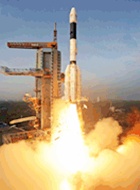ISRO’s GSLV-D5 rocket blasts off into space; India makes history
06 Jan 2014
India's Geosynchronous Satellite Launch Vehicle GSLV-D5, powered by indigenous cryogenic engine, lifted off successfully yesterday from the Satish Dhawan Space Centre in Shrihartikota, about 100 km from Chennai.
 The 49-metre rocket blasted off majestically into atmosphere leaving a long trail of thick white fumes at 16:18 hrs Sunday after its automatic launch sequence programme set off at 16:06 hrs.
The 49-metre rocket blasted off majestically into atmosphere leaving a long trail of thick white fumes at 16:18 hrs Sunday after its automatic launch sequence programme set off at 16:06 hrs.
GSLV-D5 carried GSAT-14 communications satellite which was successfully put into a Geosynchronous Transfer Orbit (GTO) just 17 minutes after the launch.
Thrilled by the mission a success, ISRO chairman K Radhakrishnan said ''I'm happy that ISRO has done it.''
''This is another major achievement for the GSLV programme and I would say this is an important day for science and technology, for space technology in the country as 20 years of efforts in realising the cryogenic engine and stage has now fructified," Radhakrishnan said.
"This shows the maturity of the team. We dedicate the proud moment for the country," he further added.
"The launch has been so precise that the satellite was put just 40 metres within the 179-km perigee and only 50 km off the 36,000-km apogee," mission director K Sivan said.
Congratulating the scientists, prime minister Manmohan Singh said the launch marked "another important step that the country has taken in the area of science and technology".
The historic launch followed over two decades of ''toiling'' and two earlier failures. In 2010, ISRO's first indigenous cryogenic engine failed less than a second after the cryogenic stage was ignited. A redesigned GSLV-D5's launch had to be abandoned just hours before its lift off due to leak in its fuel tank.
GSLV, which can carry heavier payloads to geostationary orbit, remained a challenge thus far although India's Polar Satellite Launch Vehicle (PSLV) programme has been continuing successfully with 25 launches.
With the successful launch of GSLV-D5, India became the sixth nation in the world after the US, Russia, Japan, China and France to have joined the indigenous cryogenic engine capability.
GSLV-D5 vehicle is configured with three stages using solid, liquid and cryogenic fuels respectively. It is capable of injecting 2-tonne class satellites into GTO.
Cryogenic stage is technically very complex due to the use of liquid hydrogen and liquid oxygen as propellants which liquefy at extremely low temperatures.
India started developing cryogenic system 20 years ago aiming to replace the engines procured from Russia.
GSAT-14, India's twenty third geostationary communication satellite will join the group of nine operational satellites which will augment the capacity of extended C and Ku band transponders. Weighing 1982 kg, it is powered by 2,600 W of solar power and Lithium-ion batteries, and has a designed life span of 12 years.
After its injection into GTO by GSLV-D5, the satellite's own propulsion system will be used to finally place it in the geostationary orbit.
Speaking to reporters after the launch, Radhakrishnan said that India will look for heavy satellite launch contracts from foreign customers after it successfully launches one more geostationary satellite.
"After flying one more GSLV, we will be in a position to declare the rocket as commercially operational," Radhakrishnan said, adding that in another 12 months, the next GSLV rocket will be ready for a mission.
With its likely lower cost, ISRO is confident of bagging commercial satellite launch contracts, as the current mission is estimated to have cost just around Rs360 crore, or just about $58 million.






























